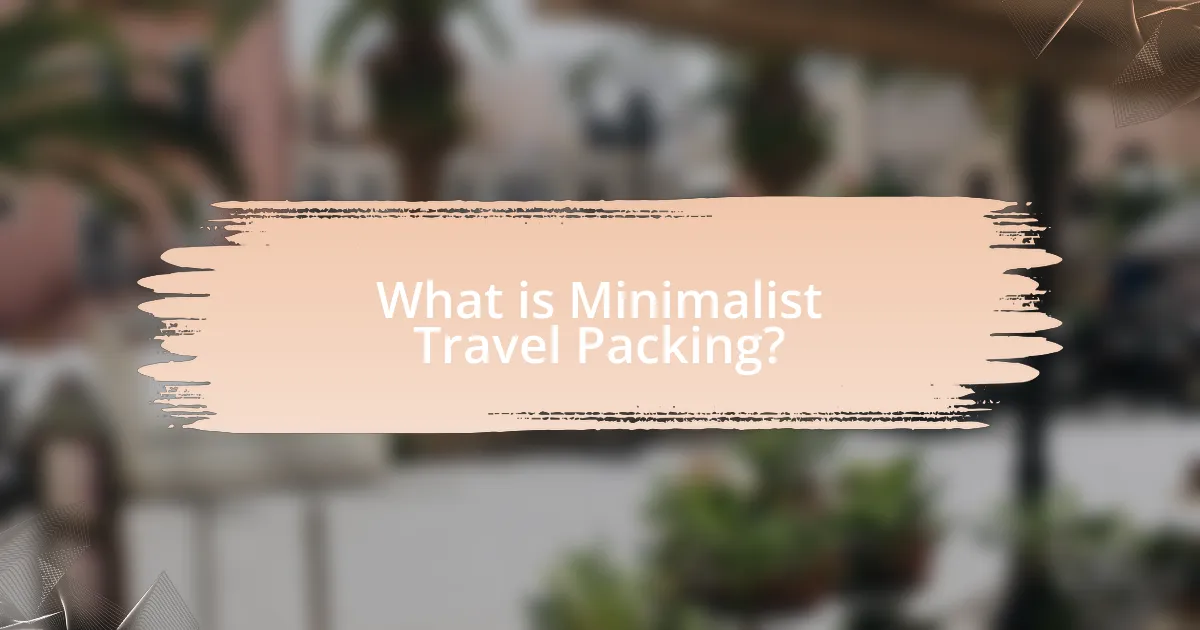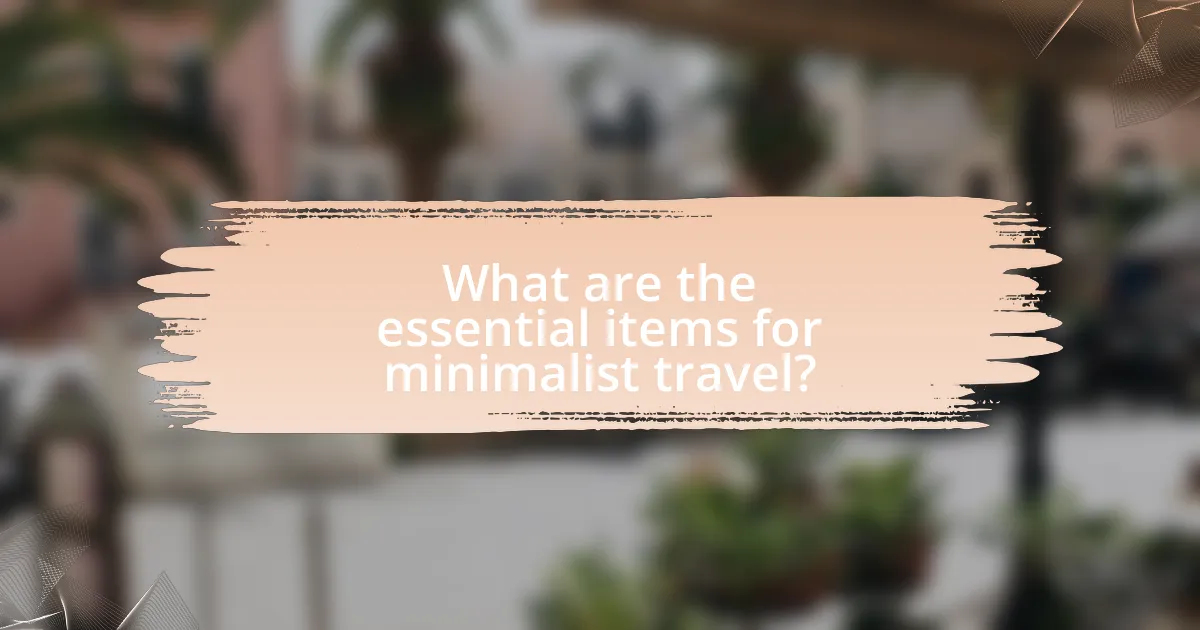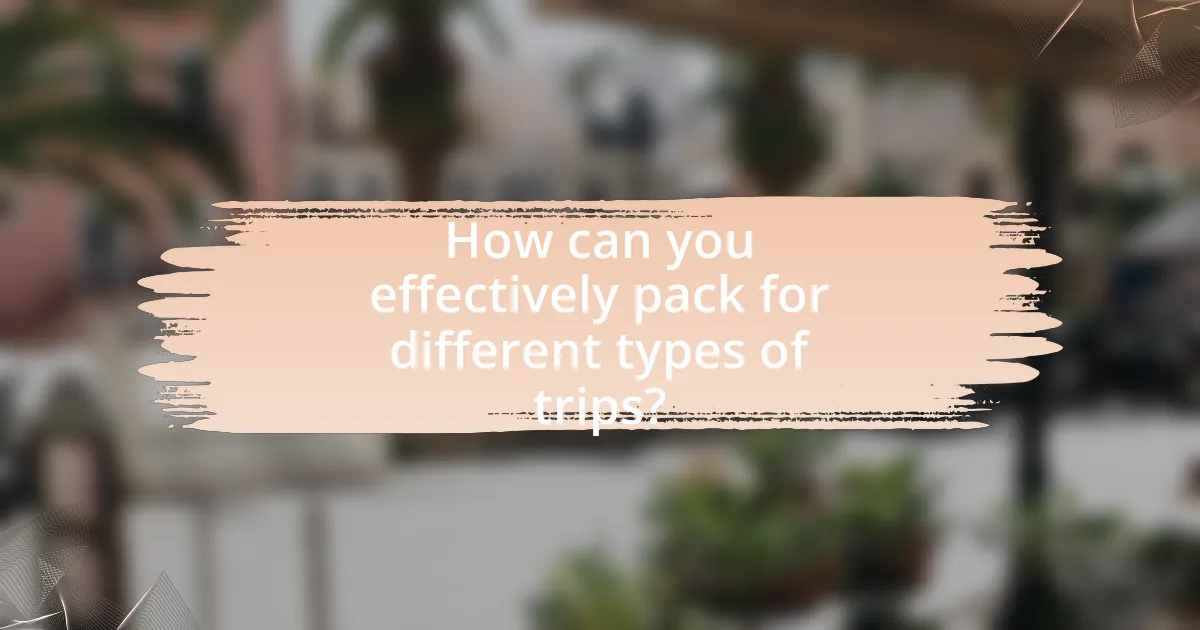The article “Packing Smart: A Guide to Minimalist Travel Essentials” focuses on the concept of minimalist travel packing, which emphasizes reducing luggage to essential, versatile items that enhance mobility and convenience. It contrasts minimalist packing with traditional methods, highlighting the benefits of prioritizing functionality and efficiency. Key principles include selecting multi-purpose clothing, minimizing weight, and organizing essentials effectively. The article also discusses the growing popularity of minimalist packing due to its cost-saving advantages and reduced travel stress, while providing practical tips for packing efficiently for various trip types and climates.

What is Minimalist Travel Packing?
Minimalist travel packing is the practice of reducing luggage to essential items, focusing on versatility and functionality. This approach encourages travelers to select a limited number of clothing and gear that can be mixed and matched, thereby minimizing weight and maximizing convenience. Research indicates that minimalist packing can lead to a more enjoyable travel experience by reducing stress and increasing mobility, as evidenced by studies showing that travelers with lighter loads report higher satisfaction levels during their trips.
How does minimalist travel packing differ from traditional packing?
Minimalist travel packing focuses on reducing the number of items to only essential and versatile pieces, while traditional packing often involves bringing a larger variety of clothing and accessories for different occasions. Minimalist packing emphasizes functionality and efficiency, encouraging travelers to select multi-purpose items that can be mixed and matched, whereas traditional packing may lead to overpacking and carrying unnecessary items. Studies show that minimalist travelers often report less stress and greater mobility, as they navigate with lighter luggage compared to those who adhere to traditional packing methods, which can result in cumbersome bags and logistical challenges.
What are the core principles of minimalist travel packing?
The core principles of minimalist travel packing include prioritizing essential items, maximizing versatility, and minimizing weight and bulk. Prioritizing essential items means selecting only what is necessary for the trip, which reduces clutter and enhances mobility. Maximizing versatility involves choosing clothing and gear that can serve multiple purposes, such as a jacket that can be worn in different settings or outfits that can be mixed and matched. Minimizing weight and bulk is achieved by selecting lightweight materials and compact designs, which allows for easier transport and adherence to airline baggage restrictions. These principles are supported by the growing trend of minimalist travel, which emphasizes efficiency and simplicity, making travel more enjoyable and less stressful.
Why is minimalist packing becoming increasingly popular?
Minimalist packing is becoming increasingly popular due to its efficiency and the growing desire for simplicity in travel. Travelers are recognizing that packing fewer items reduces stress, saves time during travel, and often leads to a more enjoyable experience. A study by the Global Business Travel Association found that 60% of business travelers prefer to travel light to enhance mobility and flexibility. This trend is also fueled by the rise of budget airlines and the associated baggage fees, prompting travelers to adopt minimalist packing strategies to avoid extra costs.
What are the benefits of packing smart for travel?
Packing smart for travel maximizes efficiency and minimizes stress. By organizing and selecting essential items, travelers can save time during packing and at security checkpoints, leading to a smoother travel experience. Research indicates that efficient packing can reduce luggage weight, which in turn can lower airline fees and make transportation easier. Additionally, smart packing encourages mindful consumption, allowing travelers to focus on experiences rather than excess belongings, ultimately enhancing the overall travel experience.
How does packing light enhance the travel experience?
Packing light enhances the travel experience by reducing stress and increasing mobility. When travelers carry fewer items, they can navigate airports, train stations, and city streets more easily, leading to a more enjoyable journey. Studies show that travelers who pack light report higher satisfaction levels due to the freedom of movement and the ability to adapt to spontaneous plans. Additionally, packing light often results in lower baggage fees and less time spent on luggage handling, further contributing to a smoother travel experience.
What impact does minimalist packing have on travel costs?
Minimalist packing significantly reduces travel costs by minimizing baggage fees and allowing for more efficient travel logistics. When travelers pack light, they often avoid checked baggage fees, which can range from $30 to $60 per flight, depending on the airline. Additionally, carrying only a personal item or a carry-on can expedite airport processes, reducing costs associated with time lost in queues or potential missed flights. Studies indicate that travelers who adopt minimalist packing can save an average of 20% on overall travel expenses due to these factors.

What are the essential items for minimalist travel?
The essential items for minimalist travel include a versatile clothing selection, a compact travel bag, a reusable water bottle, a portable charger, and a basic toiletry kit. Versatile clothing allows for multiple outfits with fewer pieces, while a compact travel bag ensures easy mobility. A reusable water bottle reduces waste and keeps travelers hydrated, and a portable charger is crucial for keeping devices powered. A basic toiletry kit with travel-sized essentials minimizes bulk while ensuring personal hygiene. These items collectively support a streamlined travel experience, emphasizing functionality and efficiency.
How do you determine what to pack for minimalist travel?
To determine what to pack for minimalist travel, prioritize essential items based on the duration and nature of your trip. Focus on versatile clothing that can be mixed and matched, and include only necessary toiletries in travel-sized containers. Research indicates that minimalist travelers often pack fewer than 10 clothing items for a week-long trip, emphasizing the importance of functionality and adaptability. This approach not only reduces luggage weight but also simplifies the travel experience, allowing for easier mobility and less stress.
What categories of items should be prioritized in minimalist packing?
In minimalist packing, the categories of items that should be prioritized include clothing, toiletries, electronics, and essential documents. Clothing should consist of versatile, lightweight pieces that can be mixed and matched, reducing the overall volume while maximizing outfit options. Toiletries should be limited to travel-sized essentials to maintain hygiene without taking up excessive space. Electronics should focus on multifunctional devices, such as a smartphone that can serve as a camera, GPS, and communication tool. Essential documents, including identification and travel itineraries, are crucial for smooth travel and should be easily accessible. Prioritizing these categories ensures that travelers maintain functionality and convenience while minimizing bulk.
How can you choose versatile clothing for travel?
To choose versatile clothing for travel, select items that can be mixed and matched, layered, and worn for multiple occasions. Versatile clothing typically includes neutral colors and classic styles that can transition from day to night, such as a simple black dress or a pair of dark jeans. Fabrics that are wrinkle-resistant and quick-drying, like polyester blends or merino wool, enhance functionality and ease of care while traveling. According to a study by the Travel Industry Association, travelers prefer clothing that offers comfort and adaptability, indicating that practical choices significantly enhance the travel experience.
What tools and accessories can aid in minimalist packing?
Packing cubes are essential tools that aid in minimalist packing by organizing clothing and maximizing space within luggage. These cubes allow travelers to compartmentalize items, making it easier to access specific clothing without unpacking everything. Compression bags also serve as valuable accessories, as they reduce the volume of clothing by removing excess air, thus creating more space. Additionally, a versatile travel backpack can function as both a daypack and a carry-on, further supporting minimalist packing by eliminating the need for multiple bags. Finally, multi-functional items, such as a travel towel that dries quickly and can be used for various purposes, enhance packing efficiency by reducing the number of individual items needed.
How do packing cubes help in organizing travel essentials?
Packing cubes help in organizing travel essentials by compartmentalizing items, making it easier to locate and access specific belongings. These cubes create designated spaces for clothing, toiletries, and accessories, which reduces clutter and maximizes packing efficiency. Studies show that travelers using packing cubes can save up to 30% more space in their luggage compared to traditional packing methods, allowing for better organization and easier retrieval of items during trips.
What are the best travel gadgets for minimalist travelers?
The best travel gadgets for minimalist travelers include multi-functional tools, compact chargers, and portable water filters. Multi-functional tools, such as a Swiss Army knife, combine several functions into one device, reducing the need for multiple items. Compact chargers, like a power bank with solar capabilities, ensure devices remain charged without taking up much space. Portable water filters, such as the LifeStraw, allow travelers to drink safely from natural water sources, eliminating the need for bottled water. These gadgets enhance convenience and efficiency, aligning perfectly with the minimalist travel philosophy.

How can you effectively pack for different types of trips?
To effectively pack for different types of trips, categorize your items based on the trip’s purpose, duration, and destination. For business trips, prioritize formal attire, essential electronics, and documents, ensuring you have versatile clothing that can be mixed and matched. For leisure trips, focus on comfortable clothing, outdoor gear if applicable, and personal items that enhance your experience, such as travel guides or entertainment. When packing for adventure trips, include specialized equipment like hiking boots or snorkeling gear, and ensure you have appropriate safety items. Research indicates that travelers who plan and categorize their packing tend to forget fewer items and experience less stress, as shown in studies by the Journal of Travel Research.
What strategies should be used for short trips versus long trips?
For short trips, prioritize packing light and versatile clothing to minimize luggage, while for long trips, focus on including essential items that cater to various activities and climates. Short trips benefit from a streamlined packing list, often consisting of a few key outfits that can be mixed and matched, while long trips require a more comprehensive approach, ensuring that all necessary gear, toiletries, and clothing for different scenarios are included. Research indicates that travelers who pack minimally for short trips report less stress and greater mobility, while those on longer journeys often find that thorough preparation enhances their overall experience by reducing the need for last-minute purchases or adjustments.
How can you adapt your packing list for different climates?
To adapt your packing list for different climates, assess the specific weather conditions of your destination and select appropriate clothing and gear accordingly. For cold climates, include thermal layers, insulated jackets, and waterproof boots, as these items provide warmth and protection against the elements. In contrast, for hot climates, prioritize lightweight, breathable fabrics, sun protection items like hats and sunglasses, and moisture-wicking clothing to stay cool and comfortable. Additionally, consider the seasonal variations; for example, packing an umbrella or rain jacket for a rainy season can be crucial. This approach ensures that you are prepared for the climate, enhancing your travel experience by keeping you comfortable and safe.
What are the best practices for packing for business travel?
The best practices for packing for business travel include creating a packing list, choosing versatile clothing, and utilizing packing cubes. A packing list ensures that essential items are not forgotten, while versatile clothing allows for multiple outfit combinations, reducing the overall number of items needed. Packing cubes help organize clothing and maximize suitcase space, making it easier to access items during the trip. According to a study by the Global Business Travel Association, effective packing can lead to a more efficient travel experience, reducing stress and saving time.
How can you ensure you have everything you need while packing minimally?
To ensure you have everything you need while packing minimally, create a detailed packing list based on your itinerary and essential items. This method allows you to prioritize necessary items and avoid overpacking. Research indicates that travelers who use packing lists are 30% less likely to forget essential items, as they can systematically check off each item before departure. Additionally, consider versatile clothing and multi-functional gear to reduce the number of items needed, further supporting a minimalist approach.
What checklist can help streamline the packing process?
A packing checklist that can help streamline the packing process includes essential categories such as clothing, toiletries, electronics, documents, and miscellaneous items. For clothing, list versatile outfits suitable for the destination’s climate, including layers and accessories. Toiletries should encompass travel-sized items like shampoo, toothpaste, and a toothbrush. Electronics should include chargers, adapters, and any necessary devices. Important documents like passports, tickets, and insurance information must be organized and easily accessible. Lastly, miscellaneous items may consist of a reusable water bottle, snacks, and a first-aid kit. This structured approach minimizes the risk of forgetting essential items and enhances efficiency during the packing process.
How can you avoid overpacking while still being prepared?
To avoid overpacking while still being prepared, create a detailed packing list based on your itinerary and prioritize versatile clothing and essential items. This method ensures that you only bring what you need, reducing excess baggage. Research indicates that travelers who plan their outfits and pack according to specific activities can minimize their luggage by up to 30%. By selecting items that can be mixed and matched, you maintain preparedness without unnecessary bulk.
What are some practical tips for successful minimalist travel packing?
To achieve successful minimalist travel packing, prioritize essential items and limit your luggage to a carry-on. Start by creating a packing list that includes versatile clothing, such as items that can be mixed and matched, and opt for lightweight, quick-drying fabrics. Additionally, utilize packing cubes to organize your belongings efficiently and maximize space. Research indicates that travelers who pack minimally experience less stress and greater mobility, as they can navigate through airports and accommodations more easily. By adhering to these strategies, you can streamline your packing process and enhance your travel experience.
How can you maximize space in your luggage?
To maximize space in your luggage, roll your clothes instead of folding them. Rolling reduces the volume of clothing and allows for more efficient packing, as it minimizes air pockets and utilizes the available space better. According to a study by the American Journal of Physics, rolling clothes can save up to 20% more space compared to traditional folding methods. Additionally, using packing cubes can further organize and compress items, making it easier to fit more into your luggage.
What are common mistakes to avoid when packing for minimalist travel?
Common mistakes to avoid when packing for minimalist travel include overpacking, failing to plan outfits, and neglecting versatile items. Overpacking leads to unnecessary weight and clutter, which contradicts the minimalist approach. Planning outfits in advance helps ensure that each piece serves multiple purposes, reducing the number of items needed. Additionally, neglecting versatile items, such as clothing that can be mixed and matched or used for different occasions, limits packing efficiency and increases the likelihood of bringing excess items. These strategies are essential for maintaining a minimalist travel experience.